Imagine Taipei, but
more relaxed. That is how I would describe Kaohsiung, Taiwan's second-largest
city. Despite being laid-back, the city has evolved into a thriving metropolis
brimming with modern living necessities such as charming cafes, walking paths,
cycling routes, outdoor parks, museums, jazz bars, art districts, and more, all
surrounded by adjacent beaches and expansive, lush, forested mountains.
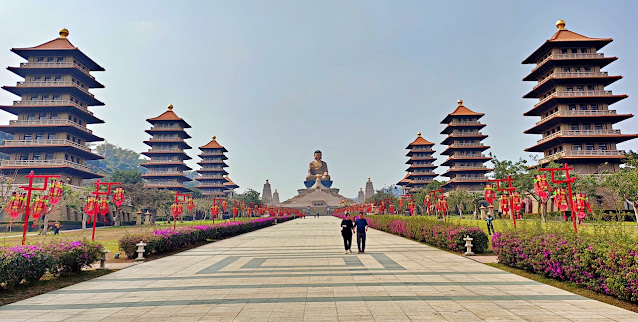 |
| Fo Guang Shan Buddha Museum |
While most tourists
are familiar with Taipei—the capital city—and its stunning blend of modern and
traditional architecture, night markets, and cultural and historical sites,
they might be surprised to learn that Kaohsiung shares much of the same vibe—albeit
with less hustle and more solitude. Here, curious visitors to Taiwan might find
a southern charm just waiting to be explored.
 |
| A trip to Taiwan always becomes a culinary journey |
It’s been a while
since I last traveled abroad, so the sighting of wide roads, spacious
sidewalks, and the presence of airy parks at almost every other block astounded
me. The city is well-known for its petrochemical and technology industries, but
it also manages to raise its residents' standard of living through thoughtful
urban planning that incorporates livable space.
 |
| The Dome of Light inside Formosa Boulevard Metro Station |
One of the most
important aspects of effortless mobility is the availability of an efficient
transportation system, and what better place to highlight Kaohsiung's
transportation than the Formosa Boulevard Metro Station? It is a three-level
underground station known for its "Dome of Light," which was designed
by Italian artist Narcissus Quagliata and is the world's largest glass
sculpture made from individual glass pieces. The art glass piece, which
consists of over 4,500 glass panels, is 30 meters in circumference and spans an
area of 2,180 square meters.
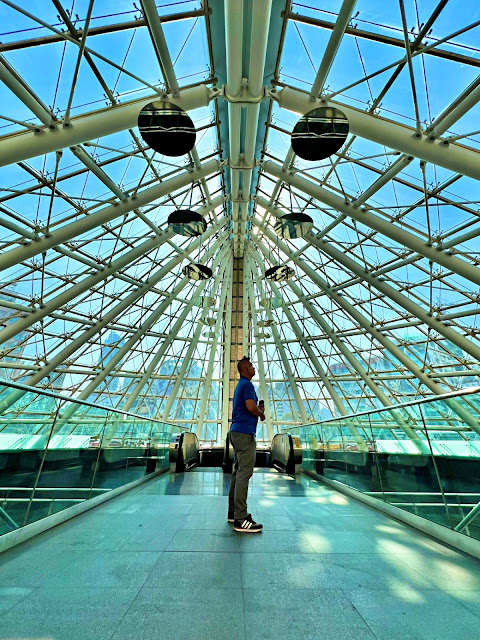 |
| Me standing near the four glass pedestrian entrance of the station |
Every day, various
light shows lasting approximately 10-15 minutes take place under the Glass Dome
route. Another noteworthy feature of the station are the four glass pedestrian
entrances designed by the world-renowned Japanese architectural firm Shin
Takamatsu Architect & Associates.
 |
| Lots of shops, galleries and cafes can be found here at the Pier-2 Art District |
In an hour, you can see a lot of the city since there's minimal traffic. We achieved just that, as we quickly found ourselves basking in the afternoon sun and refreshing breeze near the seaside, not far from the Pier-2 Art District, where converted warehouses now house galleries and art spaces.
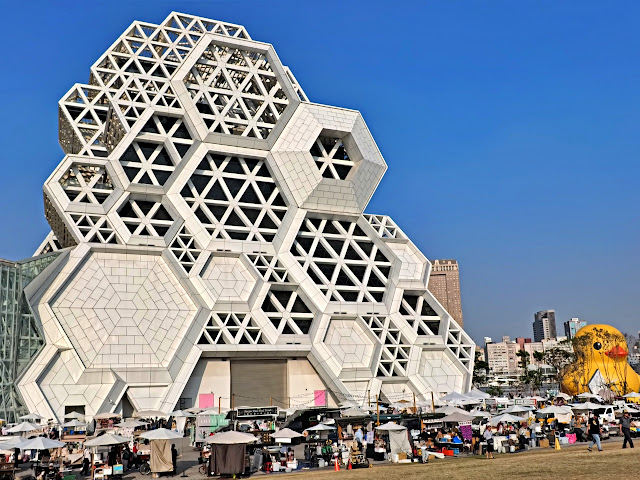 |
| The waves-inspired the Kaohsiung Music Center |
I also discovered that you could learn more about Kaohsiung's art and architecture scene by walking along the canal-side promenade that leads to the Great Harbor Bridge, where an impressive building catches your attention; the Kaohsiung Music Center, which features a geometrical shape inspired by the ocean waves and other aquatic creatures.
 |
| Kaohsiung City teems of art installations and objects. |
A
hundred steps beyond that, you’ll come across the Kaohsiung Museum of History, which
is another eye-popping structure designed in the classic imperial crown style
distinctive of Japan.
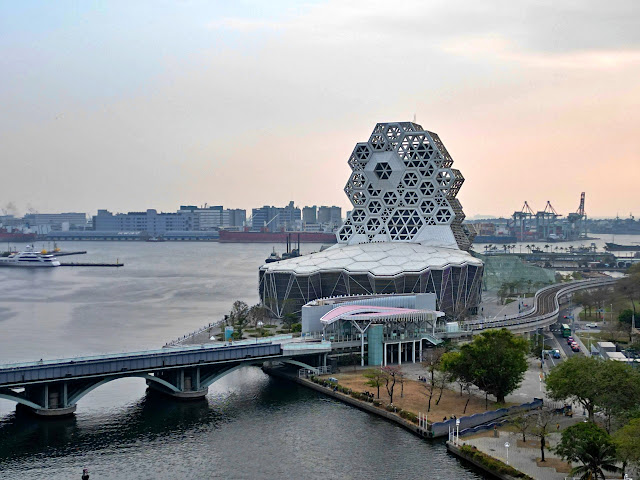 |
| The the Kaohsiung Music Center, the Pier 2 Art District as seen from my drone above the Love River |
Another attraction
in the same area is the Love River, which flows through the heart of Kaohsiung
and serves as a model of urban renewal thanks to its transformation from a
polluted river into a peaceful stretch of water surrounded on each side by
restaurants, cafes, parks, and galleries. Following the beautification of this
river, it became a popular dating place for lovers, therefore earning the name
Love River.
 |
| Basilica Cathedral of Our Lady of the Holy Rosary |
Not too far from
the bridge on the Love River, one can find the Basilica Cathedral of Our Lady
of the Holy Rosary, the oldest Roman Catholic Church in Taiwan. First established in 1858 by the Dominicans,
the church underwent various restorations before being rebuilt into its current
Gothic and Romanesque form in 1928.
 |
| Guess what? there's also a 'bibe' craze in Kaohsiung. |
There are so many
interesting locations to visit in Kaohsiung that you may not realize it, but
you'll be amazed to find that you've already walked over 20,000 steps.
A Taste of
Kaohsiung’s Street Food Culture
Despite a long day
and more than 20,000 steps, we didn’t let the opportunity to explore
Kaohsiung’s night market go to waste. The Liouhe Night Market, a
straightforward 300–400 meter street with food stalls on both sides, is a good
place to get to know Taiwan's street food culture despite being shorter than
Raohe Night Market in Taipei.
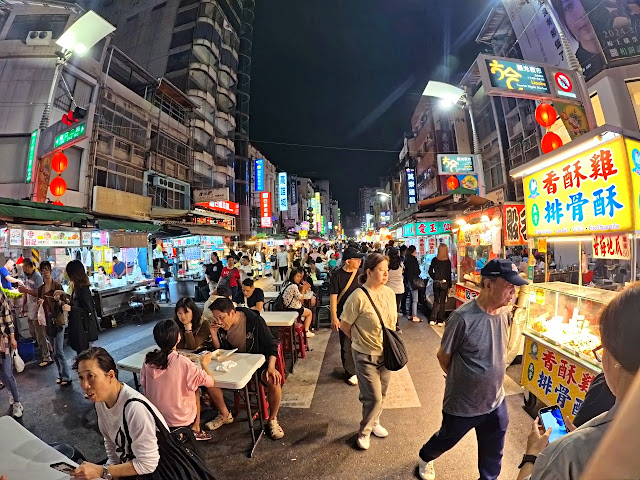 |
| The Liouhe Night Market |
The almost a
kilometer walk from our hotel worked to my advantage as I was able to tome down
what I had for dinner and create room for some street food-tripping. The staple
of Taiwanese street gastronomy were on full display and already attracting a
growing crowd by 9pm.
 |
| All kinds of grilled and deep fried food can be seen here |
For first timers in
Taiwan, it is imperative not to miss the mysterious stinky tofu, which is an
acquired taste and one of the hallmarks of Taiwanese cuisine. Having tried it
in my earlier visit to Taiwan, I took a pass this time and focused on the
others that made me drool to no end. There's the oyster omelet, green onion and
oyster cake, taro balls, peanut ice cream wraps, oyster vermicelli, gua
bao—also known as Taiwanese hamburger, albeit saucier—fried chicken fillet,
mango shaved ice, grilled squid, gao bao (pork belly buns), flame-torched beef,
Taiwanese sausage, and more.
 |
| Come hungry, leave full and satisfied |
While I would have
like to sample everything, I settled for a Taiwanese sausage from one booth,
some green onion and oyster cake from another, and a glass of bubble tea to
wash it all down.
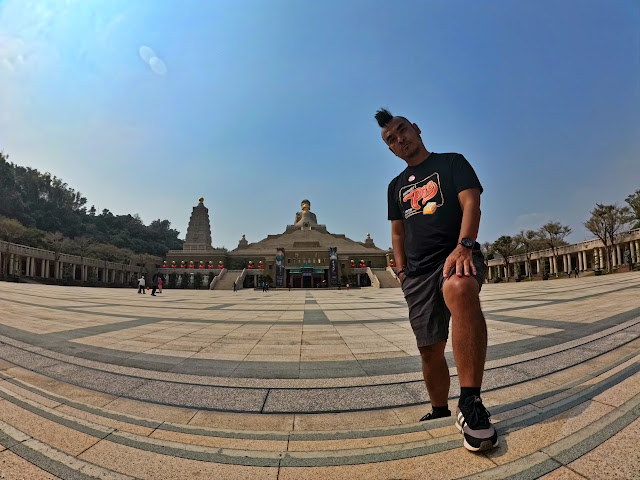 |
| Me in front of the giant Shakyamuni Buddha at Fo Guang Shan Buddha Museum |
Before proceeded to
Tainan, we wrapped up our Kaohsiung media familiarization tour with a stop at Fo
Guang Shan Buddha Museum.
 |
| Inside one of the galleries in Fo Guang Shan Buddha Museum |
Widely regarded as
Buddhism's spiritual epicenter in southern Taiwan, a visit to Fo Guang Shan
Buddha Museum provides an excellent opportunity to delve deeper into the
Buddhist teachings. Laid out over hilltops spread over thirty hectares,
visitors can explore a variety of religious and educational sites, including
historic Buddhist temples as well as the more modern Buddha Museum.
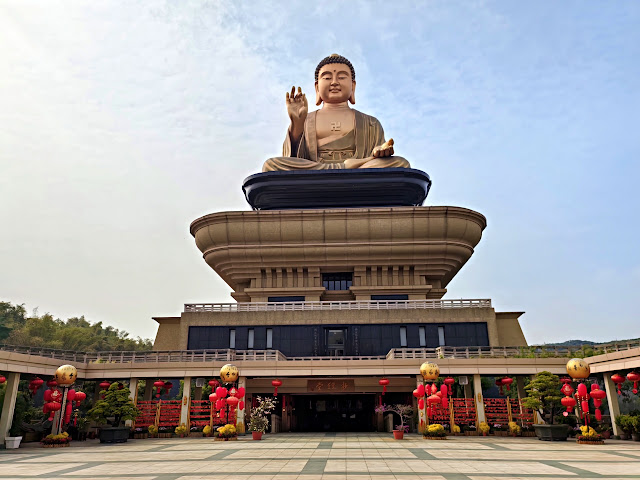 |
| Expressed my gratitude for the good karma that brought me back to Taiwan |
Eight symmetrical
pagodas line up a wide walkway in the Buddha Museum, with a main hall and a
gigantic statue of Shakyamuni Buddha at the end. The pagodas house exhibits,
interactive spaces, and a wedding hall for Buddhist ceremonies. Several
galleries display fascinating Buddhist artifacts and relics in both permanent
and scheduled exhibitions, while the main hall is home to numerous shrines.






















